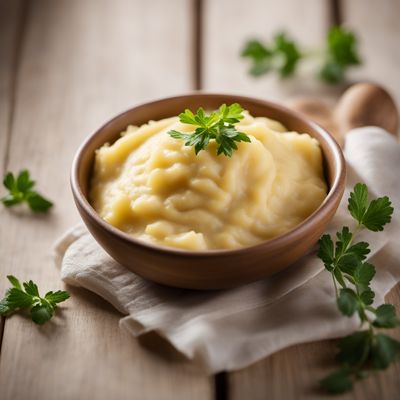
Ingredient
Potato puree
Creamy Delight: Exploring the Versatility of Potato Puree
Potato puree is a smooth and velvety mixture made by cooking and mashing potatoes until they reach a creamy consistency. It has a rich and buttery taste with a mild earthy flavor. The texture is silky and luscious, allowing it to blend seamlessly with other ingredients. Potato puree is typically pale yellow or white in color, depending on the variety of potatoes used.
Origins and history
Potatoes are native to the Andes region of South America and have been cultivated for thousands of years. They were introduced to Europe in the 16th century and quickly gained popularity due to their versatility and ability to thrive in various climates. Potato puree became a popular dish in European cuisine, particularly in countries like France and Ireland, where it is commonly known as "mashed potatoes."
Nutritional information
Potato puree is a good source of carbohydrates, providing energy for the body. It also contains essential vitamins and minerals such as vitamin C, potassium, and vitamin B6. However, it is important to note that the nutritional content may vary depending on the preparation method and additional ingredients used.
Allergens
Potato puree is generally allergen-free, but individuals with potato allergies should avoid consuming it.
How to select
When selecting potatoes for making potato puree, choose ones that are firm, smooth, and free from blemishes or sprouts. Look for potatoes with a uniform size to ensure even cooking. Avoid potatoes that are green or have a strong odor, as these may indicate spoilage.
Storage recommendations
Store potato puree in an airtight container in the refrigerator for up to 3-4 days. To maintain its freshness and quality, cover the surface of the puree with plastic wrap to prevent it from drying out.
How to produce
Amateur cooks can easily produce potato puree by boiling peeled and diced potatoes until tender, then mashing them with butter, milk, or cream until smooth. Adding salt and pepper to taste enhances the flavor.
Preparation tips
To achieve a creamy and smooth texture, it is important to thoroughly cook the potatoes until they are fork-tender. Adding warm milk or cream gradually while mashing helps to incorporate it evenly and prevent lumps. For a richer flavor, consider adding butter or herbs such as garlic or rosemary. Potato puree can be used as a side dish, a base for soups or stews, or as a filling for savory dishes like shepherd's pie.
Substitutions
Mashed cauliflower or parsnip puree can be used as a substitute for potato puree in recipes that require a lower carbohydrate content or a different flavor profile.
Culinary uses
Potato puree is a versatile ingredient used in a variety of dishes. It is commonly served as a side dish, accompanying roasted meats, grilled fish, or sautéed vegetables. It is also a key component in dishes like potato gnocchi, potato pancakes, and potato croquettes. In desserts, potato puree can be used to make cakes, pies, and even ice cream.
Availability
Potatoes are widely cultivated and available in most regions around the world, making potato puree easily accessible.

